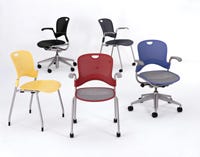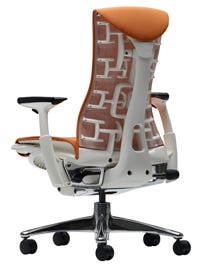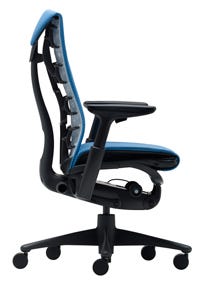Market Snapshot: Furniture
Focus on the right design and end market can increase growth in this category. Plastic is playing a larger role in the furniture market, particularly in the areas of office, medical, and mass transportation seating. That’s a shift from what’s generally been thought about plastic furniture such as the outdoor variety.
December 3, 2008
Focus on the right design and end market can increase growth in this category.
Plastic is playing a larger role in the furniture market, particularly in the areas of office, medical, and mass transportation seating. That’s a shift from what’s generally been thought about plastic furniture such as the outdoor variety.
|
Proof of the shrinking plastic outdoor furniture market can be found in a study by Cleveland-based market research firm The Freedonia Group, which shows demand for it slowing, predicted to rise just 1.2% annually to $225 million in 2011. Gains are expected to be the slowest of any major outdoor furniture category, largely due to the supplanting of plastic by other types of furniture.
Additionally, since most plastic furniture is considered a commodity product, pricing pressures are expected to remain intense, which will limit market gains. In its favor, however, is its low cost, ease of care, and good weatherability. Furthermore, plastic storage benches and boxes will provide some opportunities, said The Freedonia Group report.
In an attempt to overcome the low-end look of plastic outdoor furniture, Freedonia points to companies such as Grosfillex (Robesonia, PA), which produces its plastic furniture in an array of colors, new product styles (such as Adirondack chairs), and improved materials. The company makes outdoor chairs, tables, and umbrellas from its proprietary Rexform and Kevring resin formulations. The company’s Rexform material replicates a textured teakwood grain, while its Kevring resin formulation features metallic flecks to replicate the look of cast metal.
Some manufacturers are experimenting with expanded polystyrene (EPS) foam coated with polyurethane to create lightweight furniture that mimics the appearance of cast aluminum and cast iron products. “Despite these efforts, plastic outdoor furniture is expected to continue to lose market share to other materials, particularly metals,” the report says.
The weak outlook is causing some consolidation and contraction in this market. For instance, Freedonia reports that Vassallo closed its Syroco subsidiary in June 2007. Syroco, which Vassallo acquired in September 2004, had been one of the leading producers of resin furniture in the United States and operated four manufacturing plants.
Medical and office furniture
If plastic is seen as a commodity material, the value-add for using resin in furniture comes in its market niche. For example, medical furniture is becoming a big market with chairs designed for specialty uses in hospitals, doctors’ offices, and institutional settings such as nursing homes. This market is expected to grow with an aging baby boomer population. Highlighting this growth is Hill-Rom Inc., a Hillenbrand Industries company (Batesville, IN) and a global manufacturer of patient support systems and other related medical technology for the healthcare industry, which reported a Q3 revenue increase of 11.7% to $366.8 million.
Additionally, there is some consolidation in the medical furniture market, with Hill-Rom reporting on Oct. 2 that it acquired Liko (Liko Vardlyft AB and Liko North America Corp.) for approximately $183 million. Liko is a manufacturer of patient lifts and accessories, and other assistive technology.
Stryker Corp. (Kalamazoo, MI) reported that its Q4 net sales increased 13.7% to $1.653 billion, while medical/surgical equipment sales surged 16.2%, marking 31 consecutive months of double-digit growth. Net earnings for the quarter were $273.8 million. The company makes a variety of products that include furniture such as overbed tables, beds, transfer equipment, and entire rooms such as its Maternity Suite line.
Moldmaker Viking Tool & Engineering (Whitehall, MI) is seeing more demand for hospital furniture. Viking’s president Jeff Cussimanio says the company recently completed a large headboard mold for a hospital bed application. Viking also specializes in molds for most of the major players in the office furniture industry, such as Haworth (Holland, MI), Steelcase (Grand Rapids, MI), and Herman Miller (Zeeland, MI). The majority of the molds the company builds run primarily polypropylene or nylon, and some glass-filled nylon.
“I’m seeing a lot of activity in the furniture market and just-completed molds for a new chair for Steelcase,” says Cussimanio. Viking also built three molds for several components of Herman Miller’s new Embody chair. “We’re building some complex molds for the furniture industry, some that are every bit as complicated as automotive molds,” he says. “We also recently completed molds for Haworth to mold a back and seat combination, or just a back.”
Flexibility is the name of the game, says Larry Walck, business development director for Mack Molding (HQ in Arlington, VT). “The expectation of the furniture OEMs is that the design will be scalable—some with arms, some without, polymer seating or foam seating, fabric or molded rubber—whatever their options—but one tool will do it all,” says Walck. “It really means all the OEMs are wanting to offer their customers choices and whatever is chosen needs to be scalable. They want to accomplish this with a single set of tooling. Adaptability and scalability are important, and the OEMs expect more to be done with the same amount of tooling, which means, from our side, creativity is key.”
The right design
Walck explains that there are five major trends in the furniture market with respect to plastics: materials, processing, market-specific requirements that drive product development such as medical or mass transportation seating, ergonomics, and made in the USA. “Design for user health/ergonomics is key, no matter what seating market you’re in,” adds Walck.
That means more upfront discovery is taking place. Each piece of furniture is being designed by the OEM for a target market, so each must have specific functionality and material characteristics, and must meet specific requirements. Consequently, Walck adds, molders in this market need to have good upfront engineering capabilities and materials processing engineering expertise, and be creative in helping the furniture OEM get what it needs, depending on the market(s) it serves.
Each furniture market has its own specific criteria, whether it’s green or target-specific needs such as medical. “The OEM might come to us and say, ‘Here’s the look we need, here’s what it has to do, and here are the performance characteristics we need,’” says Walck. “It’s not so much aesthetics as performance of the materials. Do we use memory polymers instead of fabric when designing a seat? It might be a matter of reducing fatigue for someone sitting in front of a computer screen all day. Or for mass transportation, does it have to be low-smoke and fire resistant? Again, it depends on the market specifics they’re going after.
“The neat thing is that the resin guys out there are in tune with the OEMs and gearing their resins to those markets as well,” says Walck. “We can pick off the shelf what we need and tweak it slightly for each customer’s needs. Materials have come such a long way, and with the advanced processing methods we use today, we’re not just looking for an injection molded part or structural foam part. Processing is being continually pushed. Can we do twin-shot or gas assist, or insert molding with any combination of those two?”
The result of all of this is that ultimately the OEM enjoys less assembly, better functionality, and a cooler look for its furniture. “When you get into mass transportation seating, you’re also picking up weight savings on a bus,” adds Walck. “Through molding technology, we’re saving customers 25 lb of bracketry, which translates into less fuel and a reduced carbon footprint. All this needs to be packaged with scalability to make it work for today’s furniture OEMs.”
Sustainability and ergonomics
Like most products today, furniture is becoming a “green” market. OEMs have their own green approach and reducing their carbon footprint is a big consideration, notes Walck.
Herman Miller works with the McDonough Braungart Design Chemistry (Charlottesville, VA) protocol, a certification program called Cradle-to-Cradle or C2C, for products whose materials are perpetually circulated in closed loops to maximize material value without damaging the ecosystem. In applying the protocol, materials in products are first inventoried and then evaluated according to their characteristics within the desired application, and placed into one of four categories (Green, Yellow, Orange, or Red) based on human health and environmental relevance criteria.
Herman Miller’s new Caper stackable side chair is designed for hard-working, multiuse spaces, and also is in keeping with Herman Miller’s commitment to environmental stewardship. Caper uses a high percentage of recycled content and is 100% recyclable at the end of its useful life. Its design requires minimal use of materials and components, which also minimizes production costs. The Caper is MBDC Silver C2C certified, which means it is composed of environmentally safe and healthy materials, is designed for material reuse in a closed-loop system such as recycling or composting, and is assembled using 100% renewable energy.
Haworth Inc. also participates in the C2C protocol, winning Silver certification in June 2008 for its Planes collection of tables, carts, credenzas, and podiums.
Ergonomics is also increasingly important for much of the furniture being designed today. Steelcase Inc. takes a holistic approach to office ergonomics. “We look at posture and movement, how people feel and work, and how the surrounding environment influences acoustics, temperature, and air quality, all of which impacts people’s health and well-being,” according to a company source.
Mack’s Walck says that many of the ergonomic seating designs in office furniture are translating into other seating requirements. “We can introduce a technology in office seating and apply it to a tractor seat,” he explains. “We’re seeing designs cut across a lot of areas, allowing the OEMs to be as creative and aggressive as they want to be. We’re having fun seeing some of the creative ideas the OEMs are coming up with and how they embrace these new ideas. It’s a fascinating time to be in this business.”
WEB EXTRA
Embody: A chair for the body and the mind
If you feel like having a Zen moment, the Embody chair from Herman Miller is probably the place for an om or two. Embody is the latest design in Herman Miller’s office chair collection, and began in the design studio of Jeff Weber and the late Bill Stumpf. They had an idea: What if a chair could positively impact people so they can work and live better?
|
Embody is designed specifically for people who sit at their computers, and features health-positive features including an instinctive back that fits the unique spinal curvature of each user; Pixelated Support, which distributes the user’s weight to help keep blood circulating; a narrow back rest that lets users move their arms freely; and the Embody tilt, which encourages seated movement.
The University of California San Francisco Ergonomics Lab conducted the study of backrest loads and postures as subjects sat in Embody and four other chairs with different kinematics. Subjects wore a series of infrared markers on the bony landmarks of the right side of the body. The chairs in this study included both suspension and foam construction chairs, and measured backrest pressure, area, and forces as subjects sat in a range of postures over the course of approximately 45 minutes.
Researchers at the Rehabilitation Institute of Chicago/Northwestern University’s Dept. of Physical Therapy and Human Movement Sciences measured the tissue perfusion (exchange of oxygen and carbon dioxide) in subjects who were sitting still for 10 minutes on different seating surfaces—Embody, suspension, or foam. The amount of oxygen/CO2 in the tissues is a function of the blood that is able to reach the tissues, and that was the primary measure in this study.
Marquette University Mechanical Engineering & Exercise Science captured metabolic measures (heart and lungs) of subjects sitting in Embody or another conventional foam and fabric chair and performing a range of standard office tasks. Subjects sat for about 2 hours in each chair while wearing a heat monitor around their chest and a mask over their nose and mouth. This study found and measured a reduced heart rate while subjects sat in Embody.
The results included a consistently lower heart rate for a majority of the tasks as subjects sat in the Embody chair than in the conventional chair. Compared to the conventional chair, heart rate ranged from 2.6 to 3.4 fewer beats per minute (bpm) for female users of the Embody chair for six of the eight tasks, while heart rate ranged from 4.6 to 7.9 fewer bpm in male subjects for all eight tasks.
Embody is a new reference for comfort, say Herman Miller sources, and supports people intuitively, allowing them to be undistracted and focus on their work.
I’ll say om to that!—[email protected]
The Freedonia Group | www.freedoniagroup.com
Grosfillex | www.grosfillexfurniture.com
Haworth Inc. | www.haworth.com
Herman Miller Inc. | www.hermanmiller.com
Hill-Rom Inc. | www.hill-rom.com
Mack Molding | www.mack.com
MBDC LLC | www.mbdc.com
Steelcase Inc. | www.steelcase.com
Stryker Corp. | www.stryker.com
Viking Tool & Engineering Inc. | www.vikingtooleng.com
About the Author(s)
You May Also Like







